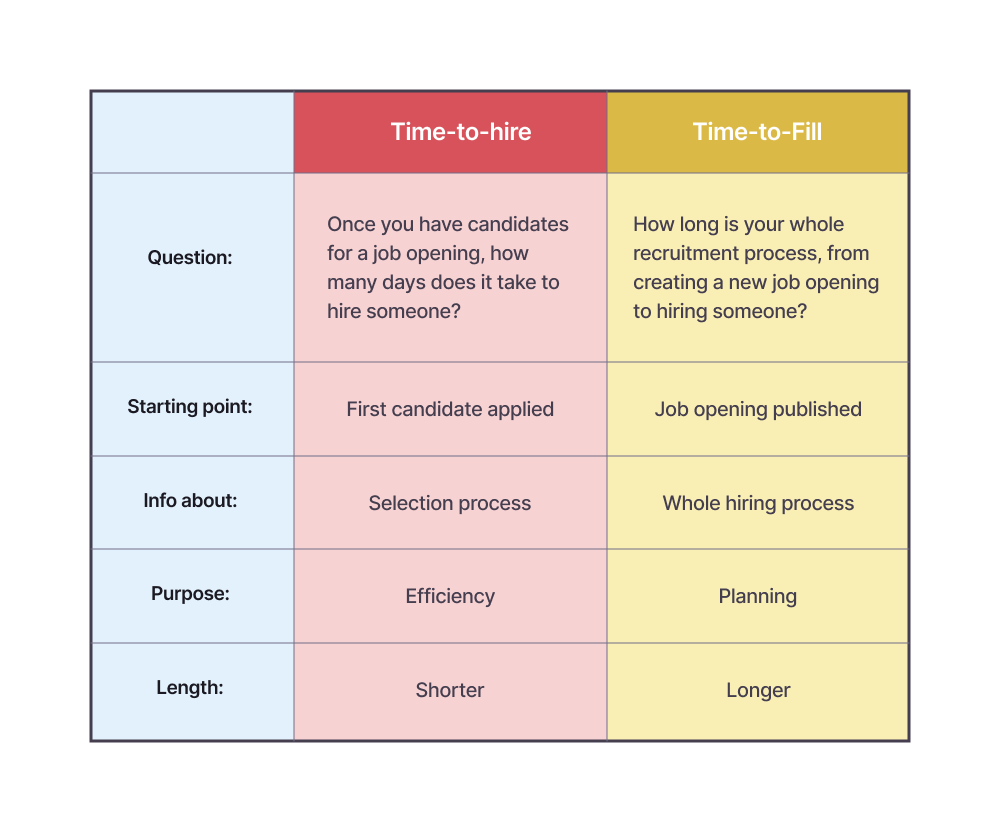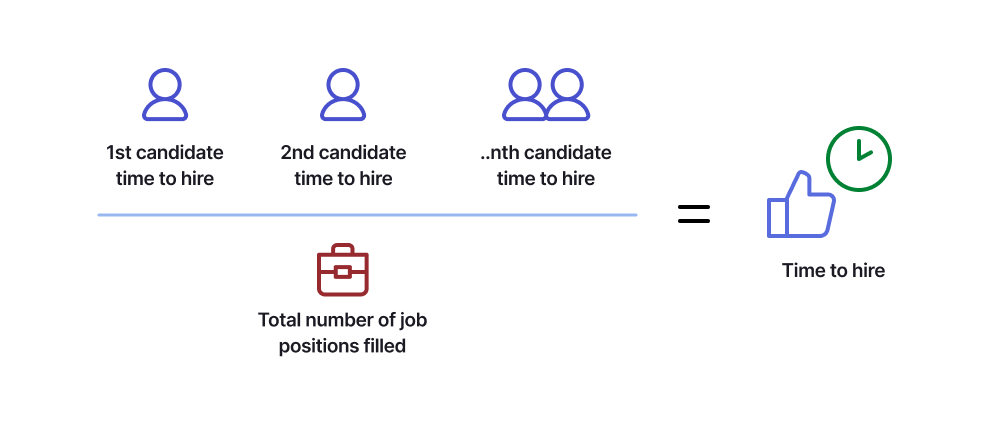In the world of recruitment, speed is the name of the game.
A sluggish hiring process can cost you top talent and drain your resources fast.
Knowing how long it typically takes your company to fill a position can help you spot where things slow down and make improvements.
The quicker you hire, the less you spend on vacant roles, and the sooner you bring in fantastic new team members.
This guide is packed with smart tips to help you speed up your hiring process and stay ahead of the competition.
What is the time to hire?
Time to hire is the time it takes from when a candidate first interacts with your company—whether they apply for a job or are sourced—until they accept the job offer.
This metric is crucial because it gives you a snapshot of the efficiency and speed of your recruitment process.
Unlike “ time to fill," which starts counting from the day a job opening is posted, time to hire zeroes in on the candidate’s experience and journey.
Here’s a quick comparison between time to hire and time to fill
Time to Hire vs. Time to Fill

Why do time-to-hire metrics matter?
Why all the fuss about the time to hire?
Simple: in today’s job market, speed is everything.
Top talent gets scooped up quickly, and if your hiring process drags on, you might lose out on the best candidates.
A lengthy time to hire can also indicate inefficiencies in your recruitment process, like bottlenecks in resume screening or scheduling interviews. These issues can—and should—be streamlined for a faster hiring process.
Plus, job seekers expect timely communication and a smooth experience. If things move slowly, their interest might stay strong, hurting your chances of landing top talent.
3 benefits of tracking time to hire
Tracking time to hire can be a game-changer. Here’s why:
- Improved candidate experience: A speedy hiring process leaves candidates with a great impression of your company.
- Operational efficiency: By spotting delays, you can streamline your process, cutting costs.
- Competitive advantage: Quickly hiring qualified candidates means your team stays strong, giving you an edge over competitors who might need to catch up.
3 factors affecting the time to hire
- Sourcing channels: Where you find your candidates can significantly impact your time to hire.
For example, employee referrals often lead to faster hires than job boards or social media, mainly because referred candidates might skip some initial steps and there’s already a level of trust.
- Screening processes: How you screen candidates can either speed up your hiring process or slow it down.
Long application forms, complex tests, and multiple screening rounds can extend the hiring time.
On the other hand, using AI-powered screening tools or simplifying the steps can speed things up.
- Interviewing techniques: The way you conduct interviews also matters. Traditional face-to-face interviews are compelling but can be a scheduling nightmare.
Using phone or video interviews for initial rounds can save time.
Plus, structured interviews, where each candidate is asked the same questions, can help speed up decision-making.
By understanding these key factors—sourcing channels, screening processes, and interviewing techniques—you can optimize your hiring process and improve your time-to-hire metrics.
A more efficient recruitment process saves time and resources and ensures you don’t miss out on top talent due to unnecessary delays.
How to calculate the time to hire
Formula for time to hire

Calculating the time to hire is pretty straightforward but incredibly useful.
Here’s the formula: Time to hire = Day of hire - Day of applicant’s first contact. This measures the days from when a candidate first reaches out (whether by applying or through initial outreach) to when they accept the job offer. It gives you a clear picture of how long it’s taking to bring someone on board.
Easy, right?
Examples of average time to hire calculations
Let’s see this formula in action with a couple of examples. Say candidate A applied on April 1st and accepted the offer on April 25th.
Plugging these dates into our formula gives us 25 - 1 = 24 days.
Now, consider candidate B, who first contacted you on May 10th and accepted the offer on May 31st. That calculation looks like this: 31 - 10 = 21 days.
These examples show how the formula works, giving you a tangible measure of your hiring speed.
Interpreting time to hire data
Benchmarking time to hire metrics
Knowing your time to hire is excellent, but how do you know if it’s good or bad?
Benchmarking against industry standards can give you a solid idea. The average time to hire varies widely among different industries and even different roles within the same industry.
For example, filling a tech position might take longer than a retail job due to the specialized skills required.
By comparing your numbers to these benchmarks, you can see if your recruitment process is on par, lagging, or ahead of the game.
Analyzing trends and patterns
Looking for trends and patterns in your time-to-hire data is also crucial. Are there certain times of the year when it takes longer to hire?
Do some departments consistently take longer to fill positions? Spotting these patterns can provide valuable insights and help you plan more strategically.
This analysis can lead to better resource allocation and smoother recruitment overall.
Addressing bottlenecks in the recruitment process
Identifying bottlenecks is one of the most actionable insights from your time-to-hire data.
These are the stages in your recruitment process that slow things down. It could be delayed decision-making, a lengthy background check process, or slow interviewer feedback.
Once you know where the hold-ups are, you can take steps to address them.
This might mean streamlining specific processes, introducing new tools to speed up background checks, or setting stricter timelines for interviewer feedback.
Addressing these bottlenecks reduces the time it takes to hire and improves the candidate experience, making your company even more attractive.
Improving the time to hire
Making your hiring process as efficient as possible can help you snag the best candidates before your competitors do, cut down on costs, and boost your organization’s productivity.
Improving your time to hire involves strategies that streamline the process and practices that are efficient and effective.
4 strategies for reducing time to hire
Here are four strategies to consider:
- Preparation and planning: Before posting the job, understand the role and its requirements. This will help you quickly identify suitable candidates.
- Use technology: Applicant tracking systems (ATS) and recruitment software automate hiring processes, such as screening resumes and scheduling interviews.
- Build a talent pool: Engage with potential candidates regularly, even when you’re not actively hiring. This way, you have a ready list of potential hires.
- Streamline interviews: Cut down on the number of interview rounds and ensure interviewers are prepared with standard questions.
Implementing efficient recruitment practices
Here are some practical steps to make the recruiting process more efficient:
- Clear job descriptions: Write clear and detailed job descriptions that accurately reflect the role’s requirements. This helps attract the suitable candidates.
Craft a perfect job description in seconds with Kula AI
- Effective communication: Keep candidates informed at every stage of the hiring process. Prompt communication can significantly enhance their experience.
- Feedback loop: After each recruitment cycle, evaluate what worked and what didn’t. Implement changes based on feedback from candidates and the hiring team.
By focusing on these strategies and practices, organizations can significantly reduce their time to hire, making their hiring process more competitive and efficient.
Addressing the time-to-hire metric is essential for maintaining a competitive edge in the talent market.
By reducing hiring time, you can improve your recruitment process, provide a better candidate experience, and build a strong workforce that drives your organization forward.
We encourage you to implement the strategies discussed in this guide. Streamlining your recruitment process, leveraging technology, and enhancing communication can make a significant difference.
Start making these changes today, and see how they help you attract and retain top talent more effectively.
For more tips and resources on improving your recruitment process, explore our other blogs at Kula.ai.
